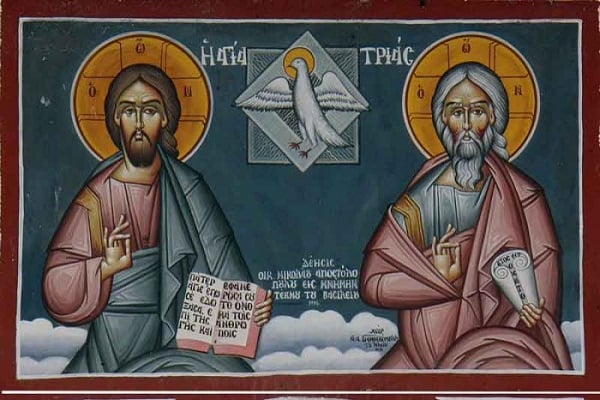Encyclical on Bearing an Icon of the Holy Trinity in a Procession
27 July 2018Since a question was asked at our office concerning the propriety of bearing an icon of the Holy Trinity in a procession, the theological advisor to the Holy Metropolis of Mani, Georgios Filias, Professor of Liturgics at the University of Athens, was asked to respond and he did so in the following manner, with which we concur.
Metropolitan Chrysostomos III of Mani
Depicting the Holy Trinity
§1 The depiction of the Holy Trinity is an offshoot of the theology of the Church and records the relationship between the three Persons. It is well known that, in Orthodox iconography, it is admissible to depict only that which we have seen and which has happened historically, the visions of the prophets and the symbols of the incarnate Son and Word of God, of the Mother of God and the Saints.
In the Orthodox Church, depictions of the Father and the Holy Spirit are not permitted, since, in many passages, Holy Scripture forbids the representation of the invisible Godhead. According to the Orthodox Church, the Incarnation of the Word presents us with the possibility of depicting the Son alone, and only in His human nature. As time went by, in the late Byzantine period and afterwards, the view gained support that the Father without beginning should also be portrayed, since He had appeared to the Prophet Daniel as ‘The Ancient of Days’.

The depiction of the Holy Spirit as a dove is permitted only in the icon of Theophany, at which He did, indeed, appear ‘in the form of a dove’. It is also permissible to represent the descent of the Holy Spirit at Pentecost, when ‘separated tongues, like fire’ came and settled on the heads of the Apostles. (Acts 2, 3).
§2 In the Orthodox Church there are two depictions of the Holy Trinity as a whole: the first is the representation of three angels which bears the inscription ‘The Holy Trinity’ or ‘The Hospitality of Abraham’. This depiction is traditional and the one which is most widely acceptable.
The second depiction is the scene presenting the three Persons of the Holy Trinity, that is the Father as an old man with white hair and beard, the Son pictured sitting on His right hand, and the Holy Spirit, in the form of a dove, hovering between them. This form of the depiction of the Holy Trinity, as we said above, is known from the last years of Byzantium and the post-Byzantine era, and was the result of Western influence.
There is a third representation, in which the whole of the Trinity is depicted, though without the subject of the icon referring to it as such. It is the icon of the Lord’s Baptism and is the one which perhaps best represents the Holy Trinity.
3§ Let us dwell further on the depiction of the Holy Trinity through the event of the hospitality of Abraham.
Apart from the explicit evidence of the New Testament, there are also intimations to be found in the Old regarding the dogma of the Holy Trinity. One of these is the appearance of God to Abraham in the form of three men. In Genesis (18, 1), it mentions that while Abraham was sitting near the oak of Mamre, where he had camped, he was visited by three men who were strangers. Abraham welcomed them cordially and with love and then treated them to a splendid meal. During their discussion, the unknown visitors announced to Abraham that his wife, Sarah, would soon produce a son, as, indeed, she did.
In this Biblical event, the Fathers of the Church saw a prefigurement of the mystery of the Holy Trinity, which was revealed fully in the New Testament. Since, in the continuation of the Biblical narrative, two of these three men appeared as angels, all three of them are depicted in icons in the form of angels. An icon of this type was known and revered in ancient times at the location of the hospitality of Abraham, according to the witness of Efsevios (Eusebius) of Caesarea. In many icons of the hospitality, the angel in the middle dominates the scene. This is because of the interpretation of the event by certain Fathers of the Church (John Chrysostom, John the Damascan).
In the hospitality of Abraham, the Fathers saw Christ appearing with two angels, though some (Cyril of Alexandria, Ambrose of Milan) interpreted the visit of the three men as an adumbration of the whole of the Holy Trinity. It is worth noting that the middle angel is not only greater in size than the other two, but he is the only one holding a scroll. This is a characteristic feature of the depiction of Christ, from as early as the first Christian years. Because of this and because he has a halo with crosses embedded, it has been claimed that this is a representation of Christ, or, according to others, of God the Father. In the other depiction of this type (where the angels are represented as being the same, without any difference in size, or other features), the aim of the icon is to declare the equality of the Persons of the Holy Trinity.






